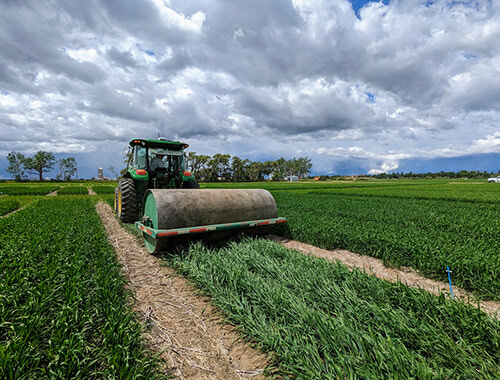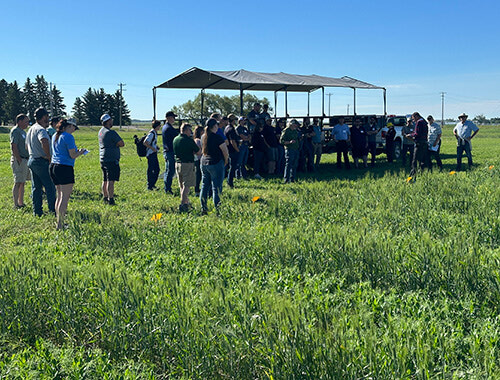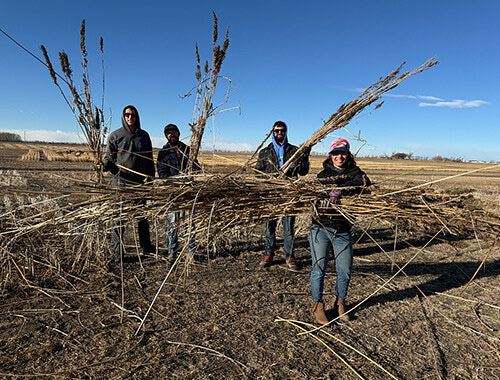Evolving Field Research
Our Field Tested team wrapped up a large part of a bigger project in 2022.
They took our Precision Planting project to the farm level – working with more than 12 independent farmers over the past four years. This work helped bridge the gap between the comprehensive small plot work our Agronomy Research team had undertaken and commercial farming at a field-scale.
In the first three years of the study, the team focused on precision planting canola. However, in the fourth and final year, the trials grew to include chickpeas and lentils. In all four years, trials were done on both irrigated and dryland farms.
For the project, all trials seeded with the precision planter were done at 15” rows while the air seeder was set to 10” rows. While precision planters are typically set to 22” row spacing, the small plot research done by our Agronomy Research team demonstrated a negative impact on canola yield when using these wider rows, and a yield advantage when using narrower rows. In order to field validate the performance of narrower rows, the first hurdle for our Field Tested team was to find farmers with planters set to 15” row spacing.
“This project has taken a lot of collaboration,” says Lewis Baarda, Field Tested Team Lead.
To complete a study of this magnitude, we worked alongside local farmers and companies, and had them working together. Not every farmer we partnered with had the necessary equipment in the necessary configuration for this trial, which added an extra challenge of coordinating between equipment owner and field owner.
Not only was coordination required to seed each trial within a narrow window of time, but it was also required to ensure that fertility was equal across all treatments. It was an incredible feat for our team to undertake, but ultimately it let us develop our existing relationships as well as build new ones between the farmers.
|
|
|
Image Caption: The discs of the precision planter used in this study, Lethbridge, 2021. |
Insights and Outlooks
Our endeavour into adapting the small plot precision planter research into a field-scale study showed great promise for the equipment.
Before our Field Tested team took the project to the field-scale, our Agronomy Research team established
the framework behind the theory. These field-scale trials have demonstrated the importance of testing within a practical setting. Interestingly, while the trials remained the same in each field, every location had a unique outcome depending on the local environment and conditions.
In our small plot trial, we saw a yield advantage with the precision planter at narrower rows. In our attempts to replicate this at the field-scale, we found the planters to be an excellent tool for seeding canola and chickpeas. However, we also found instances where the planters, if improperly configured for the field and conditions, may run into limitations. Thankfully, while the limitations proved detrimental to the performance of the planter, they did not create a major yield deficit!
Under ideal conditions, the planters performed well. However, the planters we used were not well-equipped to deal with zero tillage and residue management. These two conditions proved to be challenging for an unprepared planter – especially corn stubble.
“In one case, we went into corn stubble with canola, and it was obvious that our machine wasn’t set up to clear the heavy, intense residue. The precisions planter bounced over it and missed patches within the row,” says Baarda.
Because air drills are better designed for zero-tillage systems, they performed slightly better than our precision planters in high residue or zero tillage environments. However, while the planter didn’t perform optimally under these conditions, it still showed that it could be a competitive alternative to an air drill. Additionally, the margin of performance between the two methods showed that if your planter was equipped to better handle these conditions, it would perform just as well or possibly better than a seeder.
Another field condition that demonstrated some limitations for the precision planter in our trials was irregular terrain
“When we seeded on a hilly area, the planter would bounce around and affect the seeding depth. I’m not sure if it was the changes in angles, but steep hills did not play nicely with our equipment,” Baarda adds.
Overall, we were very happy with the observations from this study. Already, we’ve seen advancements in precision planter technology to overcome most of the limitations demonstrated in our field trials. Alternative seeding methods are always exciting, and we’re excited by the opportunity for producers to adopt this practice in canola and especially in chickpeas.
|
|
|
Image Caption: Precision planted canola beside precision planted chickpeas, Lethbridge, 2021. |
The Competitive Edge
Normally, a planter would not be used when seeding chickpeas, yet we saw great establishment in the crop across our trials, opening potential for further research into this interaction.
Ultimately, the precision planter proved to be a competitive alternative to an air drill seeder. The primary benefit of the planter being the more uniform seed placement and better depth control (when properly deployed). This results in better emergence, better crop stand, and potentially better yields.
Our field-scale study proved that the planter does perform competitively relative to an air drill. However, while we didn’t observe the same yield advantages we saw in our small plot research, this could likely be attributed to the residue management issue discussed in the article.
If you would like to read more about this project, or our small plot counterpart, check out or Precision Planting project page!
|
|
|
|
Image Caption: A comparison of canola trials in the Field Tested Precision Planter study. Left, canola seeded by the air drill seeder. Right, canola seeded by the precision planter. |
|









